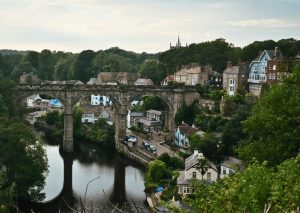Brutalist architecture is a bit like marmite: you either love it or loathe it. To many, it’s ugly. Cold. Monolithic. But to others, it’s honest – architecture that doesn’t hide behind ornament or charm.
I belong firmly to the pro-brutalist camp. There’s something about gigantic concrete slabs mounted together that I find compelling and visually arresting.
For a long time, Brutalist architecture in England fell out of favour but it’s definitely experiencing renewed interest. It’s England stripped to its bones. What’s more are the numerous Instagram accounts paying tribute to the style’s photogenic stark lines, raw aesthetic and overwhelming ratio of concrete.
These cool exteriors have become a blueprint for contemporary design and architecture. Their value has increased too – some apartments go on the market for hundreds of thousands, even millions. It’s a trend that feels at odds with the movement’s socialist origins.
Previously I’ve written about Brutalist architecture in London and now I want to extend the tribute across the whole of England. We all know that the capital already receives enough attention, so let’s venture further afield to look for more Brutalist buildings.
Leeds University Campus

Architects: Chamberlin, Powell and Bon
The Roger Stevens lecture hall is close to my heart. I moved out of home to Leeds when I was eighteen to go to Leeds University (I later dropped out but that’s another story) and I had the joy of attending lectures in this iconic building.
At the time I wasn’t even aware of brutalism as an architectural form, but its appearance made an impression on me. It was the first time I consciously became drawn to the aesthetic. Little did I know a few years later I would live in a flat in London built by the very same architects who built this masterpiece.
Central Hall, University of York

Architects: Robert Matthew, Johnson-Marshall & Partners (RMJM)
York is considered one of the most beautiful cities in England, famed for its medieval architecture. It’s probably no surprise then that this spaceship-looking building is often met with disdain.
Somewhat amusingly, it’s said to be a bone of contention that while students from York St. Johns University graduate at York Minister with its universally admired Gothic architecture, students from this Russell Group university graduate in this less conventionally attractive building.
Our Lady Help of Christians, Birmingham

Architect: Richard Gilbert Scott
The Grade II* listed building is a Roman Catholic church built in 1967. It is part of a group of Roman Catholic churches that were built in Birmingham at this time, reflecting the historical community of Irish immigrants who grew in the area in the post-war period.
It’s a reinforced concrete frame in-filled with brickwork, with an innovative sculptural design that sees the ribbed roof curving up into a central tower. You can’t really detect how colourful the stained glass by John Chrestien is until you go inside. It fills in the spaces left between the concrete frame letting in a soft quality of light.
Clifton Cathedral, Bristol

Architect: Ronald J. Weeks
Consecrated in 1973, unlike a lot of brutalist architecture in England, this church is well-loved within the community and architect lovers alike. This may have something to do with building’s acoustics which are said to be first-rate, making the venue popular for some of Europe’s top classical ensembles. Also, it could be something to do with the down-to-earth nature of Bristolians. Maybe a bit of both me thinks.
Perhaps even more impressive is the interior. It benefits from a lot of natural light and with a capacity that can hold around a 1000 people, it conveys a great sense of being large yet intimate at the same time. Unfortunately when I arrived, the cathedral had already closed so I could only admire it from the outside.
The seats are said to be positioned so that no one is ever far from the altar to help foster a more intimate connection with the high altar during mass.
Metropolitan Cathedral, Liverpool

Architect: Frederick Gibberd
Have I just brought together in one Brutalist bundle the holy trinity of places of worship? The Metropolitan Cathedral in Liverpool certainly has the wow factor.
There’s something extremely surprising about seeing a Brutalist church or cathedral and this one looks like a rocket ship ready to take launch. Visually, it goes against the grain and personally I don’t really associate churches with the modern world, yet I’m totally here for it.
If you’d like to see more photos of the building, the Cathedral has a superb Instagram page that features the architecture heavily. Clearly they know it’s special.
You might also like: Brutalist churches from around the world
National Theatre, London

Architect: Denys Lasdun
The National Theatre has divided public opinion since it opened in 1976 along the South Bank. Prince Charles once amusingly called it a ‘nuclear power station’. In 2001 a Radio Times poll featured Lasdun’s building in the top five of both the most hated and the most loved British buildings.
To make up your own mind, head inside for a little gander. Grab a coffee and wander around the building, or maybe catch a show. If you really want to get a thorough understanding of Brutalism, join one of the architecture tours available from the Southbank Centre.
Lecture Theatre Block, Brunel University
Architect: Richard Sheppard, Robson and Partners
There’s no other university campus in England that has its roots so firmly grounded in brutalism than Brunel University. This campus not only holds a place in the Brutalist Hall of Fame (there’s no such thing… but there should be, right?), it’s also part of cinematic history.
Some of you will recognise it as the backdrop to Stanley Kubrick’s masterpiece, A Clockwork Orange. That fact alone makes this building iconic.
Hayward Gallery, London

Architect: Ron Herron
Also located along the South Bank is the ever-striking Hayward Gallery. While being a world-famous art museum, the architecture alone is a reason to visit for many.
Since the Hayward opened in the summer of 1968 with an exhibition by Henri Matisse, it has presented work by many of the world’s most leading artists as well as championing the work of emerging artists.
After being closed for renovations, it re-opened in January 2018 with a retrospective of the work of acclaimed German photographer Andreas Gursky. Some people will be happy to know the new renovations consisted of a new roof with much-improved pyramidal lights, giving the top-floor gallery proper natural light for the first time.
During your visit be sure to visit the outdoor food market that’s located nearby. Brutalism and burritos is a combination that goes down exceedingly well.
The Barbican, London

Architects: Chamberlin, Powell and Bon
Finally, we reach my favourite venue in the whole of London: the Grade II-listed Barbican Centre. The monumental complex is Europe’s largest multi-arts venue and one of London’s best examples of Brutalist architecture. I’m not the only one who believes this either. I’ve never met a person who doesn’t like it.
The complex was developed out of a utopian vision to transform an area of London left devastated by the Second World War. After many changes from the original design, the building took over a decade to complete.
Finally, it officially opened in 1982 by the Queen. She declared it ‘one of the modern wonders of the world’. I’m sure that remark made the architects sigh with relief! Who would’ve guessed that the Queen had a liking for brutalism? I always knew she had fine taste.

Architecture tours of the building are organised for those who wish to know everything there is to know about the Barbican’s design. You can read about my review of the tour here.
Balfron Tower, London

Architect: Ernö Goldfinger
Goldfinger is considered by many the father of Brutalism. This 27-floor tower in east London is one of his most well-known creations. Goldfinger had a reputation for being a formidable man. Some of his neighbours didn’t take to him, opposing some of his planning permission.
One of those neighbours happened to be the writer Ian Flemming. In a petty act of revenge, Flemming named his most notorious Bond villain after him. As you might imagine, the architect was not too thrilled by this and tried to sue Flemming. However, he was unsuccessful.
Balfron Tower is often said to be the precursor and testbed to the larger and more famous Trellick Tower highlighted below.
Trellick Tower, London

Architect: Ernö Goldfinger
The inspiration behind J G Ballard’s dystopian classic High Rise (1975), Trellick Tower is one of London’s most divisive buildings and perhaps the most iconic example of Brutalist architecture in the city. When you see it in the flesh it’s easy to understand what all the fuss is about. Trellick Tower commands attention.
Ernö Goldfinger was a Marxist and admirer of Le Corbusier who championed towers as the solution to the British housing shortage after the second world war. Tellick Tower was certainly born from this vision, consisting of 217 flats across 31 floors, it resembles a ‘street in the sky’.
20 Bedford Way, London

Architect: Denys Lasdun
The Grade II* listed 20 Bedford Way was designed by Denys Lasdun and opened in 1977. Lasdun also built the National Theatre and the wonderful Royal College of Physician which I also recommend visiting.
Similar to others, the building was not initially well-received (brutalism really is like marmite). The 800-ft monumental façade, along with the five sentry-like service towers rising to 115 feet, attracted the most criticism.
William Curtis, an architectural historian, described it as possessing a “megastructural, elephantine quality…[that] does seem to lack subtlety and poetry”. Nevertheless, over time, it has found its way into the hearts of many – like many brutalist buildings eventually do.
What’s your favourite example of Brutalist Architecture in England?
You might also like:









